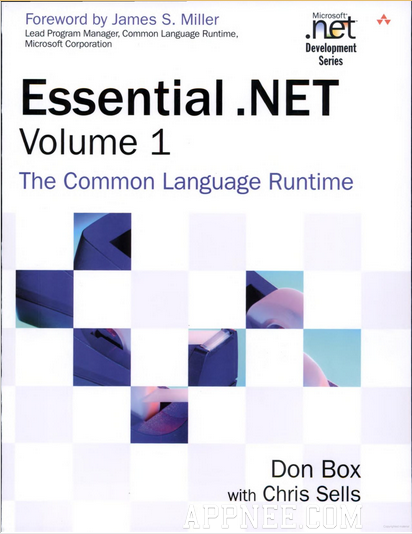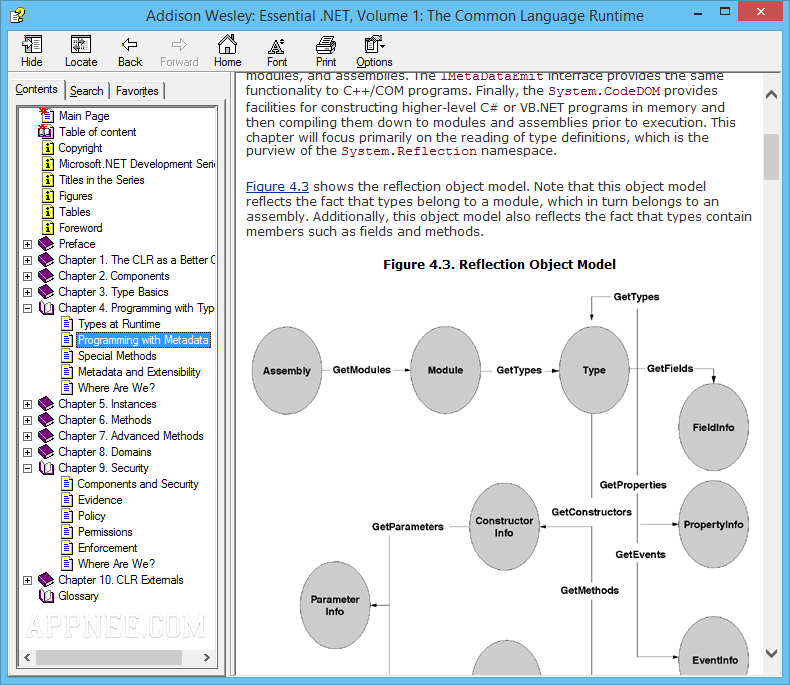| Ⅰ | This article along with all titles and tags are the original content of AppNee. All rights reserved. To repost or reproduce, you must add an explicit footnote along with the URL to this article! |
| Ⅱ | Any manual or automated whole-website collecting/crawling behaviors are strictly prohibited. |
| Ⅲ | Any resources shared on AppNee are limited to personal study and research only, any form of commercial behaviors are strictly prohibited. Otherwise, you may receive a variety of copyright complaints and have to deal with them by yourself. |
| Ⅳ | Before using (especially downloading) any resources shared by AppNee, please first go to read our F.A.Q. page more or less. Otherwise, please bear all the consequences by yourself. |
| This work is licensed under a Creative Commons Attribution-NonCommercial-ShareAlike 4.0 International License. |

Although Essential .NET, Volume I: The Common Language Runtime has only 432 pages (published in 2002), it contains a lot of practical details and expert-level advice only Don Box can provide. This provides the very important reference and guidance for developers who need to make full use of the Microsoft .NET‘s powerful features.
As a founder of Simple Object Access Protocol (SOAP) version 1.1 and Microsoft’s architect, Don Box deeply discussed the essence of .Net Framework: Common Language Runtime (CLR for short), and revealed the internal working mode of CLR. While helping readers have a more complete understanding to CLR’s working mechanism, he guides them how to use the .NET Framework to build better applications.

// Table Of Contents //
- Chapter 1. The CLR as a Better COM
- COM Revisited
- The Common Language Runtime
- The Evolution of the Programming Model
- Where Are We?
- Chapter 2. Components
- Modules Defined
- Assemblies Defined
- Assembly Names
- Public Keys and Assemblies
- The CLR Loader
- Resolving Names to Locations
- Versioning Hazards
- Where Are We?
- Chapter 3. Type Basics
- Type Fundamentals
- Types and Initialization
- Types and Interfaces
- Types and Base Types
- Where Are We?
- Chapter 4. Programming with Type
- Types at Runtime
- Programming with Metadata
- Special Methods
- Metadata and Extensibility
- Where Are We?
- Chapter 5. Instances
- Objects and Values Compared
- Variables, Parameters, and Fields
- Equivalence Versus Identity
- Cloning
- Boxing
- Arrays
- Object Life Cycle
- Finalization
- Where Are We?
- Chapter 6. Methods
- Methods and JIT Compilation
- Method Invocation and Type
- Interfaces, Virtual Methods, and Abstract Methods
- Explicit Method Invocation
- Indirect Method Invocation and Delegates
- Asynchronous Method Invocation
- Method Termination
- Where Are We?
- Chapter 7. Advanced Methods
- Motivation
- Messages as Method Calls
- Stack and Message Transitions
- Proxiable Types
- Message Processing (Revisited)
- Objects and Context
- Contexts and Interception
- Where Are We?
- Chapter 8. Domains
- Execution Scope and the CLR
- Programming with AppDomains
- AppDomain Events
- AppDomains and the Assembly Resolver
- AppDomains and Code Management
- AppDomains and Objects (Revisited)
- Where Are We?
- Chapter 9. Security
- Components and Security
- Evidence
- Policy
- Permissions
- Enforcement
- Where Are We?
- Chapter 10. CLR Externals
- Memory
- Modes of Execution
- Unmanaged Modules
- Loading the CLR
- The CLR as a COM Component
- Where Are We?
// Download URLs //
| If some download link is missing, and you do need it, just please send an email (along with post link and missing link) to remind us to reupload the missing file for you. And, give us some time to respond. | |
| If there is a password for an archive, it should be "appnee.com". | |
| Most of the reserved downloads (including the 32-bit version) can be requested to reupload via email. |
